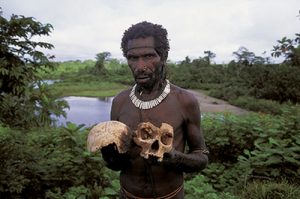Endocannibalism is a form of learned cannibalism, wherein human remains are ritually consumed by members of their kin. While endocannibalism is implemented and understood in many different contexts, I will be looking specifically at the practices of the Fore people in Papua New Guinea. I then want to compare practice of post-mortem ritual cannibalism with modern American embalming and funerary customs. These two forms of memorial services, while vastly different, give unique insights about why our deceased bodies often provoke such emotional responses.

The Fore are composed of approximately 20,000 individuals that reside in Papua New Guinea. It was not until the 1950s that the Fore began to have significant contact with members of other countries. Upon this contact, anthropologists began to observe strange behaviors that they associated with a disease called Kuru. Researchers were stumped about what was causing the disease and leading it to spread, prompting more intense investigation of the Fore people.

It was then that they discovered the Fore practiced ritual cannibalism with dead relatives. Bodies were “eaten out of love for the deceased. The dying person would normally express their wishes as to how their body was to be disposed of” as cannibalism was not the only option (Whitfield et al 2008; 3722). It was through consumption of the corpse that the family could ensure deceased souls would be recycled through the family or become ancestors, outcomes which would “assist the living” (Whitfield et al 2008; 3722).
The prion responsible for Kuru was found to be most concentrated in the brain; the disease affected women and children more often than men. These findings illuminated how specific parts of the body were designated to people depending on their relationship to the deceased member (Bichell 2016).
In modern western times, cannibalism is regarded as an animalistic behavior that is indicative of a psychological disorder. Initial interaction with the Fore promoted a lot of bewilderment because this ritual cannibalism was only understood under a western lens. However, the Fore did not regard human consumption as an act of savagery; it was instead a show of love:
“If the body was buried it was eaten by worms; if it was placed on a platform it was eaten by maggots; the Fore believed it was much better that the body was eaten by people who loved the deceased than by worms and insects. By eating the dead, they were able to show their love and to express their grief” (Whitfield et al 2008; 3722).
In contrast, popular western funerary practices involve embalming the body and putting it in a casket, as if we are ignoring the eventual and natural decomposition of the dead body. Moreover, putting our deceased in caskets seems to reflect the idea that we honor our dead by preserving them as accurate to life as possible; we dress them in familiar clothes and jewelry, and apply makeup to create the illusion of animation. While we may believe this to be the most sensible way to honor and remember the deceased, the Fore remind us that our views on life and death are not universal.

“Throughout the world, death is generally a time for the expression of strong emotional response” (Huntington and Metcalf 1979; 42). Because of this, we can be overly responsive in the face of others’ funerary practices. Coming from an American perspective, my belief is that funerary rites are so emotive due to the fact that mortuary practices illuminate the relationships we have to the deceased and to our own lives. Death usually prompts us to think about our own mortality; the way we preserve (or decompose of) a body can reflect our aspirations for how we will be remembered, reintegrated into the cosmos, or potentially reanimated.
Sources:
Jerome T. Whitfield, Wandagi H. Pako, John Collinge, and Michael P. Alpers. “Mortuary Rites of the South Fore and Kuru.” Philosophical Transactions of the Royal Society, 363, 2008, 3721–24. doi:10.1098.
Rae Ellen Bichell. “When People Ate People, A Strange Disease Emerged.” National Public Radio, September 6, 2016. http://www.npr.org/sections/thesalt/2016/09/06/482952588/when-people-ate-people-a-strange-disease-emerged
Richard Huntington, and Peter Metcalf. “The Emotional Reaction to Death.” In Celebrations of Death: The Anthropology of Mortuary Ritual, 23–43. Cambridge University Press, 1979.
Recent Comments